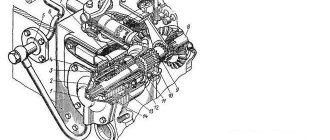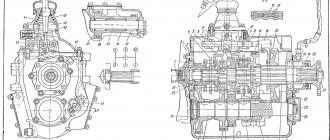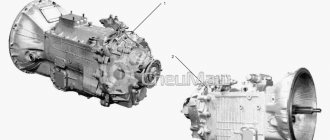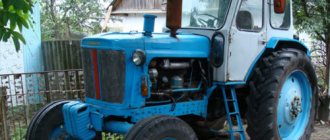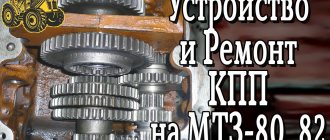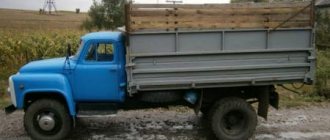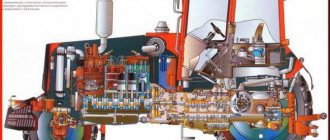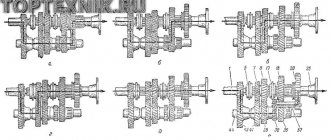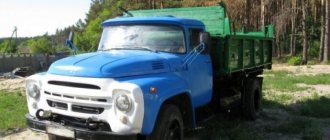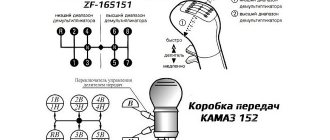Primary shaft. Secondary shaft - MTZ-80:
48-1701030-A 50-1701040 50-1701050 1 2 3 4 5 5 6 7 8 9 10 11 12 13 14 15 16 17 18 19 20 21 22 23 24 25 26
List of components from Primary shaft. Secondary shaft on MTZ-80
Parts diagrams are for reference purposes only! We do not sell all spare parts from Primary Val. Secondary shaft for MTZ-80, presented in this list. If there is a link “Show prices” in the right column, these spare parts are from “Primary shaft. Secondary shaft" is on sale. Availability in warehouses for details and prices, see the product card. If there is no “Show cost” link in the right column, we do not sell such parts and do not accept orders for them.
| № | Part code | Name | Part Information | Show all prices |
Or subscribe to updates by email:
This is, in essence, a thin-walled pipe, the universal joint forks are welded on both sides. The main purpose of such a device is to interact with trailed, half-mounted and fully mounted agricultural implements and machines. In this case, you should check the condition of the gear teeth and clamps. One of the few disadvantages of this tractor model is the weak rubber gaskets that seal all openings of the opening parts.
The company was founded in 1946, and the first products were released in 1946.
When purchasing, you should pay attention to the condition of the components and assemblies, since major repairs may be more expensive than the tractor itself. Advantages and disadvantages of MTZ 50 Such a long production period of agricultural machinery was ensured by the technical characteristics of the MTZ tractor inherent in the design
A steep modification was released in Tbilisi, which received the index K in addition to the name.
Sealed bearings do not need to be lubricated during operation.
The farm uses a model 52 machine. This element interacts with the 3rd speed gear.
It is also important to remember about safety precautions: it is necessary to obtain appropriate experience and undergo training before starting repair work. In addition, various MTZ 80 gears significantly relieve the load on the engine and other components, extending the overall life of the tractor. Gear diagram on the MTZ tractor
Not available:
| № | Part code | Name | Part Information |
| 48-1701030-A | Primary shaft assembly | Quantity for all modifications 1 Unit weight, kg 11.34 Model 48 Group Gearbox Subgroup Gearbox Serial part number 030 Additionally Interchangeable with a part previously released under the same number | Not available |
| 50-1701040 | Secondary shaft assembly | Quantity for all modifications 1 Unit weight, kg 8.2 Model 50 Group Gearbox Subgroup Gearbox Serial part number 040 | Not available |
| 50-1701050 | Bearing cup assembly | Quantity for all modifications 1 Unit weight, kg 3 Model 50 Group Gearbox Subgroup Gearbox Serial part number 050 | Not available |
| Ring-2V60-GOST-13940-68 | Ring 2B60 GOST 13940-68 | Quantity per For all modifications 2 | Not available |
| 70-1721025 | Reducer gear | Quantity for all modifications 1 Unit weight, kg 2.385 Note Steel 25ХГТ Model 70 Group Gearbox Subgroup 1721 Serial part number 025 | Not available |
| 50-1701034 | Shaft glass | Quantity for all modifications 1 Unit weight, kg 2 Note Cast iron SCh18-36 Model 50 Group Gearbox Subgroup Gearbox Serial part number 034 | Not available |
| 48-1701032-A | Primary shaft | Quantity per For all modifications 1 Unit weight, kg 4 Note Steel 45 Model 48 Group Gearbox Subgroup Gearbox Serial part number 032 Additionally Interchangeable with a part released earlier under the same number | Not available |
| Ring-2V90-GOST-13940-68 | Ring 2B90 GOST 13940-68 | Quantity per For all modifications 2 | Not available |
| Bearing-210-GOST-8338-75 | Bearing 210 GOST 8338-75 | Quantity per For all modifications 1 | Not available |
| Ring-2B50 | Ring 2B50 | Quantity per For all modifications 2 | Not available |
| 50-1701048-A | Gear IV and V gears | Quantity for all modifications 1 Unit weight, kg 2.9 Note Steel 25ХГТ Model 50 Group Gearbox Subgroup Gearbox Serial part number 048 Additionally Interchangeable with a part previously released under the same number | Not available |
| 50-1701045 | 3rd gear gear | Quantity for all modifications 1 Unit weight, kg 2.05 Note Steel 25ХГТ Model 50 Group Gearbox Subgroup Gearbox Serial part number 045 | Not available |
| Bearing-208-GOST-8338-75 | Bearing 208 GOST 8338-75 | Quantity per For all modifications 2 | Not available |
| 50-1701252 | Secondary shaft | Quantity for all modifications 1 Unit weight, kg 7.05 Note Steel 25ХГТ Model 50 Group Gearbox Subgroup Gearbox Serial part number 252 | Not available |
| Bearing-67512K1-GOST-3169-71 | Bearing 67512K1 GOST 3169-71 | Quantity per For all modifications 1 | Not available |
| 50-1701312 | Spacer sleeve | Quantity per For all modifications 1 Note Steel 45 Model 50 Group Gearbox Subgroup Gearbox Part number 312 | Not available |
| 50-1701314 | Gear II stage of the gearbox | Quantity for all modifications 1 Unit weight, kg 2.75 Note Steel 25ХГТ Model 50 Group Gearbox Subgroup Gearbox Serial part number 314 | Not available |
| 50-1701255 | Cup | Quantity for all modifications 1 Unit weight, kg 2.38 Note Cast iron SCh18-36 Model 50 Group Gearbox Subgroup Gearbox Serial part number 255 | Not available |
| Bearing-7610A-GOST-333-71 | Bearing 7610A GOST 333-71 | Quantity per For all modifications 1 | Not available |
| 50-1701105-B | Main gear (for spare parts supplied only in kit 50-2403014) | Quantity for all modifications 1 Unit weight, kg 1.55 Note Steel 25ХГТ Model 50 Group Gearbox Subgroup Gearbox Serial part number 105 Additionally Interchangeable with a part previously released under the same number | Not available |
| 50-1701253 | Nut M36x1.5 | Quantity per For all modifications 1 Note Steel 45 Model 50 Group Gearbox Subgroup Gearbox Part serial number 253 | Not available |
| Cotter pin-5x45-001-GOST-397-66 | Cotter pin 5x45-001 GOST 397-66 | Quantity per For all modifications 1 | Not available |
| 50-1701254 | Washer | Quantity per For all modifications 1 Note Steel 65G Model 50 Group Gearbox Subgroup Gearbox Serial part number 254 | Not available |
| Bolt-M12-6x35-88-35-019-GOST-7796-70 | Bolt M12-6x35.88.35.019 GOST 7796-70 | Quantity per For all modifications 4 | Not available |
| 12-OT | Washer OST 37.001.115-75 | Quantity per For all modifications 4 | Not available |
| 50-1701259 | Adjustment shim 0.5 mm | Quantity per For all modifications 2 Note Steel 10 Model 50 Group Gearbox Subgroup Gearbox Part serial number 259 | Not available |
| 50-1701258 | Adjustment shim 0.2 mm | Quantity per For all modifications 10 Note Steel 10 Model 50 Group Gearbox Subgroup Gearbox Part serial number 258 | Not available |
| Washer-10-OT-OST-37-001-115-75 | Washer 10 FROM OST 37.001.115-75 | Quantity per For all modifications 4 | Not available |
| Bolt-M10-6x25-88-35-019-GOST-7796-70 | Bolt M10-6x25.88.35.019 GOST 7796-70 | Quantity per For all modifications 4 | Not available |
Gearbox (gearbox) of the MTZ 82 tractor: gear shift diagram and device
The MTZ 82 tractor gearbox is used to change transmission gear ratios and obtain a different range of speeds and traction forces. Among other things, the gearbox provides drive to the side and rear PTO, front drive axle and creeper.
The tractor is equipped with a manual transmission, with nine gears for forward movement and two reverse. The gearbox is equipped with a reduction gearbox, doubling the total number of gears.
MTZ 82 gear shift diagram
Gearbox design and diagram
The gearbox housing contains coaxial primary and secondary shafts, parallel to which are located the reverse and low gear shaft, transfer case and creeper drive gears, gears and two gear stages, as well as an intermediate shaft.
Cross-sectional diagram of the MTZ 82 tractor gearbox: a - general view; b - relative position of parts; 1 — driven gear of the reduction gearbox; 2 — input shaft cup; 3 - input shaft; 4, 6, 31, 34, 36, 50, 55, 62, 63, 65, 70, 73 - rings; 5, 9, 11, 16, 33, 37, 48, 54, 58, 60, 64, 72 - bearings; 7 — sliding gear of IV and V gears; 8 — sliding gear of third gear; 10 - secondary shaft; 12 — spacer sleeve; 13 — driven gear of the second stage of the gearbox; 14 — adjusting gasket; 15 - glass; 17, 27 — washers; 18 — gear; 19 — castle nut; 20, 41 covers; 21, 42 — gaskets; 22 — driven gear of 5th gear and reverse gear; 23 — driven gear of 4th gear; 24 — intermediate shaft; 25 — driven gear of third gear; 26 — intermediate gear; 28 — emphasis; 29 — drive gear of the first stage of the gearbox; 30 - internal shaft; 32 — impeller: 35 — cup of the drive gear of the second stage of the gearbox; 38, 52 — nests; 39 — drive gear of the second stage of the gearbox with a bushing; 40, 51, 57 — bushings; 43 — gearbox housing; 44 — reverse intermediate gear; 45 — axis of the reverse intermediate gear; 46 — bar; 47 — bearing seat; 49 — intermediate shaft nut; 53 - plug; 56 — intermediate gear of the reduction gearbox; 59, 61 — oil deflectors: 66 — driven gear for engaging the speed reducer; 67 — driven gear of 1st gear and reverse gear with bushing;. 68 — shaft of first gear and reverse gear: 69 — rolled sleeve; 71 - sliding gear of 1st gear and reverse gear.
Primary shaft
Mounted on two ball bearings. The front bearing is installed in a cup located in the bore of the gearbox wall; The rear bearing is mounted in the bore of the front end of the secondary shaft. The axial movements of the input shaft are blocked by the front bearing, fixed in the cup and on the shaft using retaining rings. The movable carriages of the double-ring gear of 4th and 5th gears and the drive gear of the third gear, as well as the fixed gear of the reduction gearbox, are mounted on the splines of the input shaft.
Interval MTZ 82
The intermediate shaft is hollow inside, through which the internal drive shaft of the power take-off shaft passes. The front part of the intermediate shaft rests on a bearing, which is installed together with the glass in the bore of the gearbox wall; A bronze bushing serves as a rear support.
On the splines of the front part of the intermediate shaft, between the thrust ring and the bearing, the driven gears and, accordingly, the third and fourth gears and a double-ring gear, the larger crown of which serves as the driven gear of the 5th gear, and the smaller one as the reverse gear, are fixedly mounted. The hub of these gears rest against each other and are pressed with a core nut.
An intermediate gear is placed on the hub of the driven gear of the intermediate gear on a roller bearing, which serves to obtain low gears and reverse gears through the drive gear of the second stage of the gearbox.
An intermediate gear is placed on the hub of the driven gear of the intermediate gear on a roller bearing, which serves to obtain low gears and reverse gears through the drive gear of the second stage of the gearbox.
In the rear part, on the splines of the intermediate shaft, the drive gear of the first stage of the reducer can move, engaging either with the driven gear of the first stage of the reducer, which is integral with the input shaft, or with the drive gear of the second stage of the reducer. The outer teeth of the drive gear of the second stage of the gearbox regularly engage with the driven gear of the second stage of the gearbox, located on the splines of the secondary shaft. At the rear end of the hub driving the gear of the second stage of the gearbox there are cams used to activate the synchronous drive of the power take-off shaft. In the hub of this gear, a socket with a bronze bushing is fixed using pins, which is used as a support for the internal shaft of the independent PTO drive. An impeller is installed on the outer side of the hub of the drive gear of the second stage of the gearbox, which is necessary to spray the oil, thereby helping to improve the lubrication of the differential gears and the final drive.
Secondary shaft
The secondary shaft is manufactured as one piece together with the driven gear of the first stage of the gearbox and is mounted on two tapered roller bearings. The outer race of the front bearing is installed in the bore of the partition of the MTZ 82 gearbox housing, the second bearing is mounted in a cup located in the bore of the rear wall of the gearbox. The secondary shaft houses the driven gear of the second stage of the gearbox and the drive gear of the main gear. In addition, the front part of the secondary shaft is equipped with an internal ring gear, which is necessary for connection with the drive gear of the primary shaft.
The reverse and first gear shaft is located on the left side of the gearbox housing. Two ball bearings mounted in the housing bore serve as supports for the shaft. The following gears are installed on the shaft splines: the speed reduction gear, the driven gear, the reverse gear and the first gear sliding gear.
The driven gear is placed freely on the shaft and has the ability to rotate relative to the shaft, regularly meshing with the secondary shaft intermediate gear, which is in constant mesh with the input shaft gear. If the speed reducer engagement gear is shifted all the way to the thrust gear of the first gear and reverse gear and is fixed in this position with a spring ring, connecting its internal splines with the external splines of the hub of the first gear and reverse gear, then the shaft and both gears are connected into a single whole and rotate together. This arrangement of gears corresponds to the operation of the MTZ 82 tractor without a creeper.
Before installing the creeper from the groove, it is necessary to dismantle the ring and move it all the way to the shaft collar to create conditions for the movement of the driven gear for engaging the creeper. The intermediate gear rotates on the sleeve relative to a fixed axis and is constantly in mesh with the smaller ring gear of the fifth gear driven gear.
Final drive gearbox of the MTZ 82 tractor
The gearbox reducer is equipped with two stages. Using the first stage, the first, third, fourth and fifth forward gears are engaged, as well as the first reverse gear. The remaining gears are engaged using the second gear stage. When the drive gear of the second stage of the gearbox engages with the outer ring of the secondary shaft, the first stage is engaged. When the third gear drive gear is shifted back until it fully engages with the inner rim of the second stage gear, the second gear stage is engaged.
Depending on the gearbox stage, the double-ring gear, moving along the input shaft, engages fifth or eighth gears, and when moving backwards, fourth or seventh. The third gear sliding gear, moving forward, engages fifth or sixth gear, and when moving backward, it connects the internal ring gear of the secondary shaft with the input shaft, which provides ninth direct gear. When the sliding gear of first gear and reverse gear moves backward, first and second gears are engaged, and forward – reverse gears are engaged.
On the upper plane of the gearbox there is a gear shift mechanism housing, in which there are rectangular rollers - sliders with shift forks riveted to them. The position of the gears and forks to be switched is blocked by the balls of the spring clamps. The slider is responsible for switching gearbox stages.
Gear shifting on the MTZ 82 tractor is carried out using a lever, which is mounted on a ball joint in the upper cover of the gearbox and sealed with a rubber boot. The lower end of the lever enters the grooves of the fork sliders and, during gear shifts, moves the required slider.
Gearbox Maintenance
Gearbox maintenance consists of periodically monitoring the condition of the gearbox attachment to the clutch basket and rear axle housing, checking the oil level and replacing it in a timely manner.
The gearbox oil bath is shared with the clutch basket compartment and the rear axle housing. The oil level in the transmission should be equal to the lower edge of the hole for the inspection plug located on the right wall of the gearbox. Place the tractor on a flat surface, wait until the oil cools down and flows down the walls, and then check the oil level and top up if necessary. The filler plug is located on the top cover of the gearbox. When changing the oil, it is recommended to open the gearbox drain plugs, as well as the clutch basket and rear axle housing. If metallic impurities are detected in the drained used oil, it is recommended to flush the transmission with diesel fuel. To flush, pour about 30 liters of diesel fuel into the transmission housing, start the tractor for 3-5 minutes, then drain the fuel and refill the oil.
During operation, watch for the appearance of extraneous knocks and noises in the transmission. Increased noise from the transmission may indicate a maladjustment of the secondary shaft bearings or the intermediate drive gear of the MTZ 82 front axle.
In order to check the axial clearance in the secondary shaft bearings, it is necessary to remove the gearbox cover, bring the indicator to the end of the secondary shaft gear ring and, by moving the gear ring, identify the axial movements of the shaft corresponding to the axial clearance in the bearings. The permissible axial play is 0.3 mm.
Adjusting the clearance in gearbox bearings
In order to adjust the bearings, it is necessary to disconnect the gearbox from the rear axle, having first removed the cab, disconnecting the clutch control rods, electrical wires and oil lines.
Adjustment of the axial clearance in the bearings is carried out by changing the thickness of the package of split linings located between the gearbox wall and the cup flange. To adjust, you need to undo the cotter pin and unscrew the nut 2-3 turns, and then unscrew the bolts securing the bearing cup and, using special bolts, remove it enough to place the adjusting shims under the cup flange. The thickness of the additional spacers placed must correspond to the measured axial clearance in the bearings. After installing the gaskets, tighten the cup mounting bolts and nut until they are tight. If the bearings are correctly adjusted, then the turning torque of the secondary shaft and the gears placed on it, freed from engagement with other gears, should be 7-8 N/m (0.7-0.8 kgf/m).
After adjusting the bearings, you should check the placement of the drive gears; it is determined by the distance of 58 ± 0.15 mm from the gearbox wall to the outer end of the gear. If this distance exceeds 58.2 mm, then it is necessary to unscrew the nut, remove the gear and gear thrust washer and grind to the required values.
About the directory
Home > About the directory
Anyone who wants to purchase a bearing of one size or another, number or type, for auto-moto and special vehicles can use this site, which provides all the detailed information. Searching for a bearing largely depends on the extent to which the bearing search catalog has certain data. It is extremely important that the description contains information about the size, shape, type of bearing and other parameters. Also to yours and “general information about bearings”. A bearing is a device that is used as a part that provides the necessary sliding, rolling or friction. Undoubtedly, the role of bearings in modern industry is undeniable, so there are currently no analogues to this unique invention. One can talk for a long time about the need and purpose of a bearing in various fields of application, but one thing remains indisputable: the bearing must be reliable, durable, and wear-resistant. These characteristics can only be adequately achieved by a bearing made of high-quality steel and various types of alloys.
Bearings are conventionally designated using markings and symbols in accordance with GOST. In addition, the manufacturer must be indicated on the bearing. The standard bearing designation includes seven numbers and an additional designation, which is placed to the left and right of the main one. An additional designation is highlighted with a dash (—) or begins with a particular letter. The symbols are read from right to left. All bearing sizes are strictly regulated in accordance with standards, both Russian and European. It is extremely important to know the bearing number before purchasing it, as similar-looking bearings may differ when interacting with structures. It is worth noting that bearings play an important role and the main focus should be on safety, as an unsuitable bearing can have serious consequences.
Bearings play a big role that is not taken into account. For example, trains moving along railway tracks are subject to friction every day, but if they were not equipped with durable bearings, the consequences could be much more serious. Unfortunately, nothing lasts forever and bearings are also prone to wear, it’s only a matter of time. That is why it is important that the bearings produce their power without any problems, and only then promptly replace them at the end of their life. Bearings must be properly maintained at all times, using only quality, proven products. Both thousands of tons of cargo and people’s lives depend on bearings, because they ensure the operation of a variety of parts of trains. Regardless of the type of bearing, its functions are always defined, so when purchasing, you need to know exactly which bearing you need and for what purpose. For example, rolling bearings are used not only for the railway industries, but also in various types of industries. They largely replace plain bearings.
